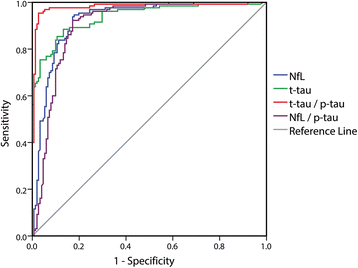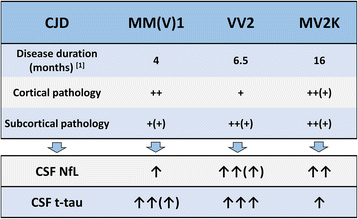The CSF neurofilament light signature in rapidly progressive neurodegenerative dementias
- PMID: 29368621
- PMCID: PMC5784714
- DOI: 10.1186/s13195-017-0331-1
The CSF neurofilament light signature in rapidly progressive neurodegenerative dementias
Abstract
Background: Neurofilament light chain protein (NfL) is a surrogate biomarker of neurodegeneration that has never been systematically tested, either alone or in combination with other biomarkers, in atypical/rapidly progressive neurodegenerative dementias (NDs).
Methods: Using validated, commercially available enzyme-linked immunosorbent assay kits, we measured cerebrospinal fluid (CSF) NfL, total tau (t-tau), phosphorylated tau, and β-amyloid 42 in subjects with a neuropathological or clinical diagnosis of prion disease (n = 141), Alzheimer's disease (AD) (n = 73), dementia with Lewy bodies (DLB) (n = 35), or frontotemporal lobar degeneration (FTLD) (n = 44). Several cases with an atypical/rapidly progressive course were included in each group. We evaluated the diagnostic accuracy of every CSF biomarker and their combinations by ROC curve analyses.
Results: In each patient group CSF NfL showed higher levels than in control subjects, reaching the highest values in those with Creutzfeldt-Jakob disease (CJD). In the latter, NfL showed a divergent, subtype-specific correlation with t-tau, depending on the degree of subcortical involvement and disease duration. Most significantly, patients with classic sporadic CJD (sCJD) MM1 showed a significantly lower concentration of CSF NfL than those with sCJD MV2, despite the much higher t-tau levels and the more rapid clinical course. High NfL levels were also detected in most atypical CJD cases, showing a disease duration longer than 2 years and/or borderline/negative results in other CSF assays (e.g., 14-3-3, t-tau, and prion real-time quaking-induced conversion). Rapidly progressive/atypical cases showed higher NfL levels than typical patients in FTLD, but not in AD or DLB. NfL showed accuracy similar to that of t-tau in discriminating CJD from other NDs, but it had higher efficacy in differentiating atypical forms, especially in regard to Alzheimer's disease.
Conclusions: The present data indicate that CSF NfL and t-tau levels reflect distinct pathophysiological mechanisms of neurodegeneration and support the clinical use of NfL as a fast screening biomarker for the differential diagnosis of atypical/rapidly progressive NDs.
Keywords: Alzheimer’s disease; Corticobasal syndrome; Creutzfeldt-Jakob disease; Dementia with Lewy bodies; Frontotemporal dementia; Progressive supranuclear palsy.
Conflict of interest statement
Ethics approval and consent to participate
The study was conducted according to the revised Declaration of Helsinki and good clinical practice guidelines. Informed consent was provided by study participants or their next of kin. Data collection of clinically suspected cases is an integral part of the national CJD surveillance study, which was approved by the ethics committee of the Istituto Superiore di Sanità (CE-ISS 09/266; 29 May 2009).
Consent for publication
Not applicable.
Competing interests
The authors declare that they have no competing interests.
Publisher’s Note
Springer Nature remains neutral with regard to jurisdictional claims in published maps and institutional affiliations.
Figures


References
-
- Parchi P, Saverioni D. Molecular pathology, classification, and diagnosis of sporadic human prion disease variants. Folia Neuropathol. 2012;50(1):20–45. - PubMed
-
- Ghetti B, Tagliavini F, Kovacs GG, et al. Gerstmann–Sträussler–Scheinker Disease. In: Dickson D, Weller RO, et al., editors. Neurodegeneration: the molecular pathology of dementia and movement disorders. 2. New York: Wiley-Blackwell; 2011. pp. 364–77.
Publication types
MeSH terms
Substances
Grants and funding
LinkOut - more resources
Full Text Sources
Other Literature Sources
Medical

